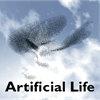通过虚拟功能磁共振成像解释战斗生物的神经进化
IF 1.5
4区 计算机科学
Q4 COMPUTER SCIENCE, ARTIFICIAL INTELLIGENCE
引用次数: 0
摘要
虽然人们对人工神经网络(ANNs)的兴趣因深度学习解决高维问题的普遍应用而重新燃起,但我们离通用人工智能还有很长的路要走。在本文中,我们通过依赖具有可变形态和神经结构的共同进化生物来解决突发认知能力的问题,更重要的是,解决它们的检测问题。前者通过静态和移动结构实现,其形状由三次样条控制。后者使用ESHyperNEAT不仅可以发现连接和权重的适当组合,还可以推断隐藏神经元的分布。这些生物整合了低级感知(触觉/疼痛本体感受器,基于视网膜的视觉,基于频率的听觉)来通知他们的行动。通过发现单个神经元和特定刺激之间的功能映射,我们提取了一个基于高级模块的生物大脑抽象。这极大地简化了发现自然发生的事件及其神经实现之间的关系。将这种方法应用于单独和标签团队共同进化的生物,显示出显著的动态,如测距和结构化的交流。这种发现是由模块化人工神经网络提供的抽象实现的,它允许将神经元组视为功能封闭的实体。本文章由计算机程序翻译,如有差异,请以英文原文为准。
Explaining the Neuroevolution of Fighting Creatures Through Virtual fMRI
While interest in artificial neural networks (ANNs) has been renewed by the ubiquitous use of deep learning to solve high-dimensional problems, we are still far from general artificial intelligence. In this article, we address the problem of emergent cognitive capabilities and, more crucially, of their detection, by relying on co-evolving creatures with mutable morphology and neural structure. The former is implemented via both static and mobile structures whose shapes are controlled by cubic splines. The latter uses ESHyperNEAT to discover not only appropriate combinations of connections and weights but also to extrapolate hidden neuron distribution. The creatures integrate low-level perceptions (touch/pain proprioceptors, retina-based vision, frequency-based hearing) to inform their actions. By discovering a functional mapping between individual neurons and specific stimuli, we extract a high-level module-based abstraction of a creature’s brain. This drastically simplifies the discovery of relationships between naturally occurring events and their neural implementation. Applying this methodology to creatures resulting from solitary and tag-team co-evolution showed remarkable dynamics such as range-finding and structured communication. Such discovery was made possible by the abstraction provided by the modular ANN which allowed groups of neurons to be viewed as functionally enclosed entities.
求助全文
通过发布文献求助,成功后即可免费获取论文全文。
去求助
来源期刊

Artificial Life
工程技术-计算机:理论方法
CiteScore
4.70
自引率
7.70%
发文量
38
审稿时长
>12 weeks
期刊介绍:
Artificial Life, launched in the fall of 1993, has become the unifying forum for the exchange of scientific information on the study of artificial systems that exhibit the behavioral characteristics of natural living systems, through the synthesis or simulation using computational (software), robotic (hardware), and/or physicochemical (wetware) means. Each issue features cutting-edge research on artificial life that advances the state-of-the-art of our knowledge about various aspects of living systems such as:
Artificial chemistry and the origins of life
Self-assembly, growth, and development
Self-replication and self-repair
Systems and synthetic biology
Perception, cognition, and behavior
Embodiment and enactivism
Collective behaviors of swarms
Evolutionary and ecological dynamics
Open-endedness and creativity
Social organization and cultural evolution
Societal and technological implications
Philosophy and aesthetics
Applications to biology, medicine, business, education, or entertainment.
 求助内容:
求助内容: 应助结果提醒方式:
应助结果提醒方式:


